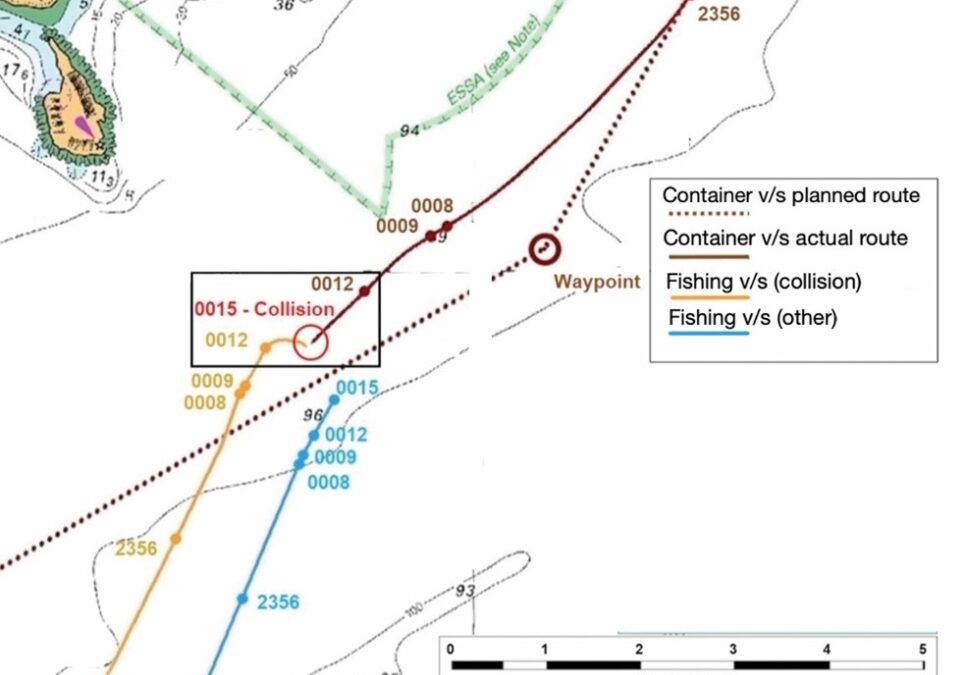When there is a risk of a possible collision, it is always a good idea to slow down to give both vessels more time to act on the situation. The Nautical Institute gives this advice in its latest Mars Report, which describes a collision between a container ship and fishing vessel.
The Nautical Institute gathers reports of maritime accidents and near-misses. It then publishes these so-called Mars Reports (anonymously) to prevent other accidents from happening. A summary of this incident:
Underway in darkness, the officer of the watch (OOW) on a medium-sized fishing boat sighted the masthead lights and green sidelight of an approaching container ship fine on the starboard bow. The ship was also detected on radar, but was not acquired for tracking at that time.
Meanwhile on the container ship, the OOW visually sighted and later acquired on radar two approaching vessels on the starboard bow, one of which was the fishing vessel. The vessels were about 10 nm from the container vessel. The OOW continued to monitor the two vessels, both visually and by radar, while making small adjustments to the heading to maintain the ship on the planned track.
At about 2356, and over the next ten minutes, the OOW made a succession of small heading alterations that took the ship to starboard in a “corner cutting” manoeuvre. The next planned course alteration would be to starboard and there was no danger in leaving the current course line.
Also read: What collisions between commercial and small vessels can teach us
Meanwhile, the watch had changed on the fishing vessel. The new OOW quickly acquired the container vessel on the radar. The ship was now about 6.5 nm away on a south-westerly course with a speed of about 17.5 knots. When the container vessel was now about 4 nm away, the fishing vessel’s OOW walked the short distance to the trawler’s bow to better assess the situation. He sighted the oncoming container vessel fine on the starboard bow with the ship’s two masthead lights nearly in a line. He returned to the wheelhouse and continued to monitor the approaching ship visually and by radar while maintaining his vessel’s course and speed.
By now, the container vessel was steady on the new course with a heading of 241 degrees with the fishing vessel fine on the ship’s port bow. About a minute later, the OOW altered the ship’s heading to port with the intention of passing between the two trawlers and increasing the CPA with the fishing vessel under review. Shortly after, the fishing vessel’s OOW commenced a rapid turn to starboard at a distance of about 1 nm from the container ship. In response, the container vessel’s OOW altered the ship’s heading to port by three degrees and flashed the ship’s Aldis lamp followed by a long blast on the ship’s whistle. The OOW then quickly changed the steering over from autopilot to hand steering and placed the wheel hard to port.
Also read: Distractions on the bridge contribute to collision between cargo and fishing vessel
Notwithstanding all of these last minute manoeuvres, the two vessels collided with the trawler’s port bow impacting the container vessel’s starboard side. As the trawler then scraped down the container vessel’s side, the skipper stopped the engine and the crew mustered in the wheelhouse. The trawler heeled over sharply to starboard and took on some water before it righted itself, passed the ship’s stern and drifted away to the north-east.
Picture: This schematic overview shows the course alterations of the container ship and fishing vessel before they collided.
Advice from The Nautical Institute
- Early and substantial action is the key to avoiding dangerous situations as above.
- Early and substantial action is not limited to course alterations. Both OOWs were concerned about the developing situation and each chose course alterations as the unique and sole solution. But, because some of these actions were not substantial enough or others too late, they actually contributed to the collision. Had either vessel slowed, the developing situation would have resolved itself.
- When in doubt, slow down.
Also read: Not reducing speed in fog leeds to vessel collision
Mars Reports
This accident was covered in the Mars Reports, originally published as Mars 202218, that are part of Report Number 355. A selection of this Report was also published in SWZ|Maritime’s June 2022 issue. The Nautical Institute compiles these reports to help prevent maritime accidents. That is why they are also published on SWZ|Maritime’s website.
More reports are needed to keep the scheme interesting and informative. All reports are read only by the Mars coordinator and are treated in the strictest confidence. To submit a report, please use the Mars report form.








